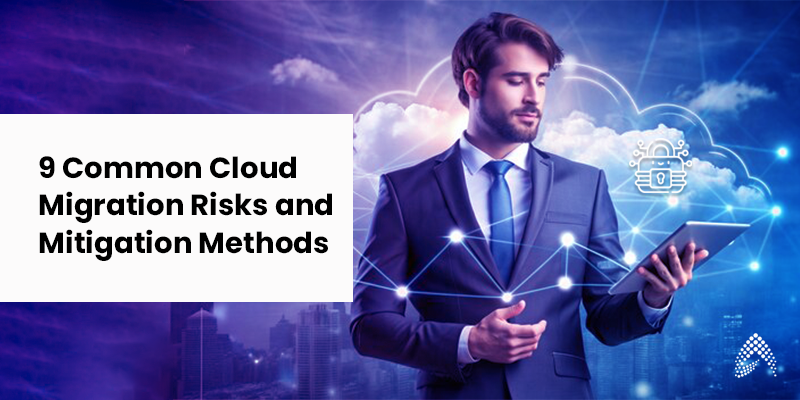9 Common Cloud Migration Risks and Mitigation Methods

Amid the increasing demand for business transformation, cloud adoption remains a top priority for C-level executives. In the USA, over 60% of organizations store their data on the cloud rather than in traditional on-premises data centers.
Cloud migration, however, requires thorough planning, execution, and a comprehensive strategy to achieve business goals. Since cloud adoption comes in all sizes and shapes – it’s imperative to select the right strategy and solution for your business.
On the other hand, cloud adoption doesn’t mean there are no problems. Cloud adoption poses numerous risks and presents unique challenges for organizations. The better an organization understands those challenges and prepares proactively to address them, the more successful and less stressful a migration will be.
Here, we discuss some common cloud adoption challenges and their solutions to help your organization better prepare for the upcoming technological transformation wave.
1. Data Security and Privacy:
In our fast-paced digital world, data is at the heart of every successful organization. But as businesses embrace the cloud, keeping data secure and private becomes a top priority. Many leaders worry about losing control over their valuable data, leaving it open to potential breaches.
Businesses must clearly understand the data they’re planning to move to the cloud. After all, the risks of breaches, data loss, and unauthorized access are no joke. They can lead to serious consequences like damage to reputation, financial loss, and hefty regulatory penalties.
40% of data breaches involved data stored across multiple environments. Breached data stored in public clouds incurred the highest average breach cost at USD 5.17 million. [IBM]
Solution:
- Regular security audits and vulnerability assessments are crucial in identifying and addressing potential security risks.
- Make sure you collaborate with cloud providers with HIPAA, GDPR, FedRAMP, ISO 27001, SOC 2, NIST Cybersecurity Framework, and other certifications to ensure security, privacy, and compliance.
- Adopting security AI and automation to predict attacks and plan mitigation strategies can cut breach costs.
- Investing in post-breach response preparedness can help dramatically lower breach costs.
2. Downtime and service disruptions
Unexpected downtimes and disruptions can take a toll on an organization’s performance, reputation, and productivity.
Factors like network congestion and data transfer overloads can disrupt cloud migrations, adding complexity to the process. Application compatibility is another significant challenge that can lead to unexpected service disruptions. Moreover, the increased vulnerability during migration heightens the risk of security breaches. Human error remains a persistent threat, with mistakes potentially leading to downtime.
Solution:
- Develop a detailed migration plan, including data backup, testing, and contingency plans.
- Conduct frequent disaster recovery drills to identify vulnerabilities and refine response procedures.
- Plan phased migration approaches to avoid unnecessary downtimes and outages.
- Conduct rigorous testing to identify and address compatibility and performance issues before the full migration.
3. Cost Overruns
According to a Gartner report, more than 70% of companies have already moved to the cloud and are eager to tap into the promise of scalability, flexibility, and cost savings. But here’s the catch: rushing into the cloud migration without a strategic roadmap can be a costly mistake and overrun budgets.
Solution:
- Understand your workload dependencies, performance requirements, and cost implications before migrating.
- Monitoring cloud usage and setting spending limits can also help prevent cost overruns.
- Identify opportunities to optimize workloads, reduce resource consumption, and select the most cost-effective cloud services.
Learn more about how to optimize your cloud spending in 2024.
4. Vendor Lock-In:
Putting all your eggs in one basket is not a good idea. Similarly, over-relying on a single cloud services provider could pose a challenge during cloud migration. During cloud migration, this can become a big challenge. It could end up being tough and expensive to switch to a different provider or bring services back in-house.
The cloud provider may increase prices over time, or the services you’re locked into could be difficult to port. This makes the system inflexible and puts the business at risk.
Solution:
- Relying on multiple cloud providers ensures interoperability and portability of applications and data and reduces vendor lock-in.
- Continuously assess vendor performance and explore alternatives.
- Ensure data can be easily extracted and transferred to other platforms.
5. Performance Issues
Moving operations to the cloud can be a game-changer, but it also comes with its fair share of risks. If not executed properly, it can lead to performance issues that disrupt business operations, causing a domino effect of lowered productivity and revenue. That’s why conducting comprehensive cloud testing is absolutely crucial to guaranteeing top-notch performance.
Remember the recent Crowdstrike outage? It was caused by insufficient testing of its Falcon content update for Windows Hosts, resulting in a major outage. This serves as a powerful reminder of the importance of thorough testing before making any major changes.
Solution:
- Conduct performance testing and benchmarking before and after migration.
- Identify potential performance bottlenecks and optimize cloud resources accordingly.
- Use cloud-native performance optimization tools to ensure compatibility and seamless performance across different cloud platforms.
6. Complex Infrastructure:
Aligning your cloud strategy with your overall IT environment can be quite challenging due to its complexity and the presence of existing applications. The complexity inherent in many organizations’ IT systems can make it difficult to develop and implement a smooth and seamless cloud migration strategy.
Solution:
- Develop a clear vision for your cloud environment that aligns with overall IT goals.
- Avoid unnecessary complexity by establishing achievable objectives for your cloud migration.
- Design a cloud architecture that seamlessly integrates with your existing IT infrastructure.
7. Legacy Systems:
Legacy applications, often built for on-premises environments, pose significant challenges for cloud migration. These legacy systems due to their age and architecture, may not be easily adaptable to cloud platforms.
Upgrading or replacing them can be risky and costly, hindering the overall migration process. Moreover, the reliance on in-house data centers to support these legacy systems creates additional complexities and potential vulnerabilities.
Solution:
- Conduct a thorough evaluation of legacy applications to determine their suitability for cloud migration.
- Prioritize applications for migration based on business value and technical feasibility, focusing on newer systems first.
- Utilize a hybrid cloud strategy to maintain on-premises infrastructure for critical legacy systems while migrating newer applications to the cloud.
8. Lift and Shift: A Double-Edged Sword
While a lift-and-shift migration strategy offers a quick path to the cloud, it often fails to realize the full potential of cloud computing. By simply replicating on-premises infrastructure in the cloud, organizations miss out on opportunities for cost optimization, scalability, and agility. This approach can also lead to vendor lock-in and hinder innovation.
Why?
The lift and shift approach lacks optimization and cloud-native compatibility, which further leads to wasted resources and performance bottlenecks,
Solution:
- Evaluate workloads to identify those suitable for lift-and-shift and those requiring optimization or modernization.
- Develop a roadmap to migrate towards cloud-native architectures for future applications.
- Customize your approach by leveraging 6 Rs of cloud migration.
Download the legacy application modernization white paper and learn how to make your migration successful.
9. Cloud Provider Selection
Selecting the optimal cloud service provider (CSP) is a critical yet challenging aspect of cloud migration. The plethora of options, each with unique strengths, pricing models, and service offerings, can be overwhelming.
Choosing the right cloud provider for your organization can be a complex decision. Factors like security, compliance, scalability, cost, and technical support can vary widely across providers, making it challenging to find the best fit. Moreover, the ever-evolving nature of the cloud market, with new services and features constantly emerging, adds another layer of complexity to the decision-making process.
Solution:
- Develop a detailed evaluation matrix to compare different CSPs based on your organization’s specific needs, such as security, compliance, cost, and scalability.
- Conduct PoCs with shortlisted providers to assess performance, reliability, and alignment with your business requirements.
- Negotiate clear service level agreements (SLAs) and exit clauses to protect your organization’s interests.
Conclusion
Cloud migration is a complex process that requires careful planning and execution. By understanding these biggest risks/ challenges associated with cloud migration and implementing effective cloud mitigation strategies, organizations can ensure a smooth transition to the cloud and maximize the potential benefits.
What’s Next
Considering a move to the cloud? Don’t let the potential risks discourage you. Get in touch with us now to set up a complimentary consultation and your cloud migration readiness evaluation.
Our team of specialists is ready to assist you in creating a tailored cloud migration plan that caters to your specific requirements and guarantees a smooth transition to the cloud.
Plus, grab a copy of our comprehensive whitepaper on how cloud-native development strategies can deliver customer-centric business solutions.

Director – Global Delivery




